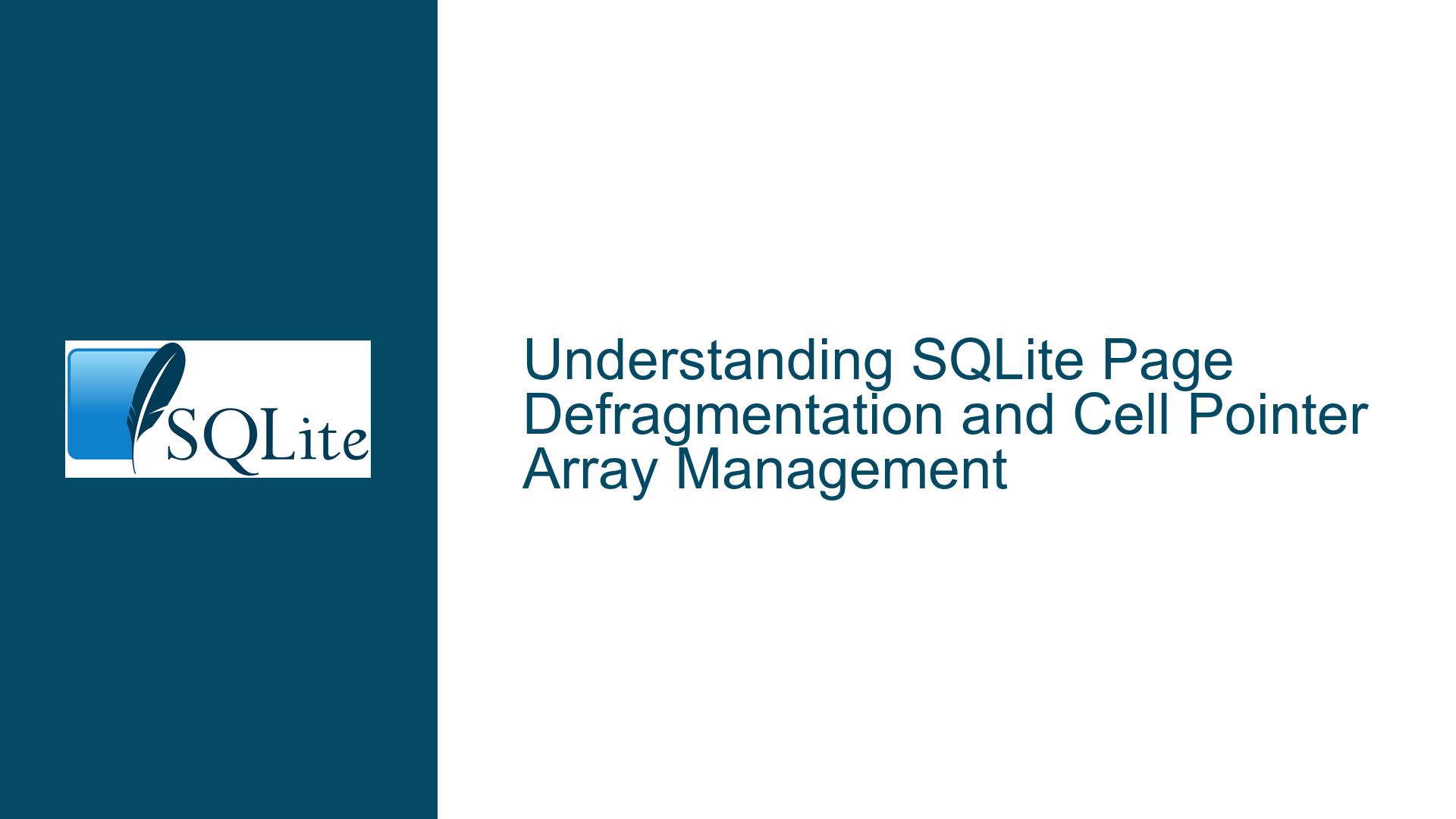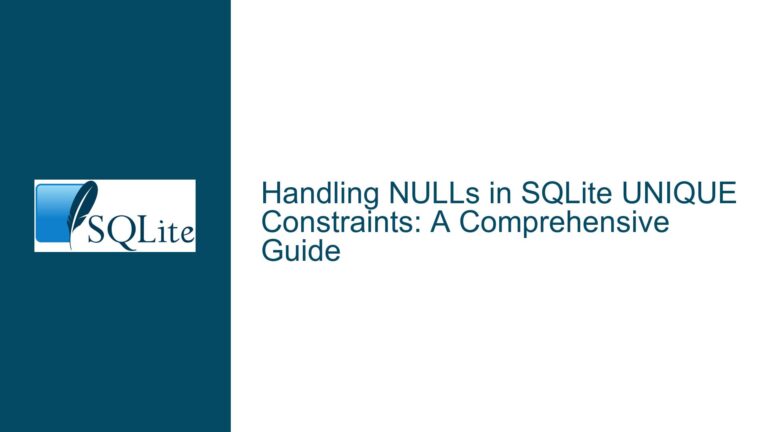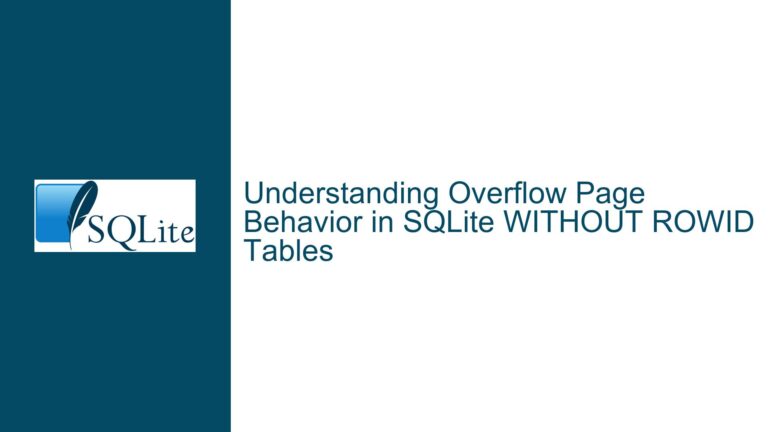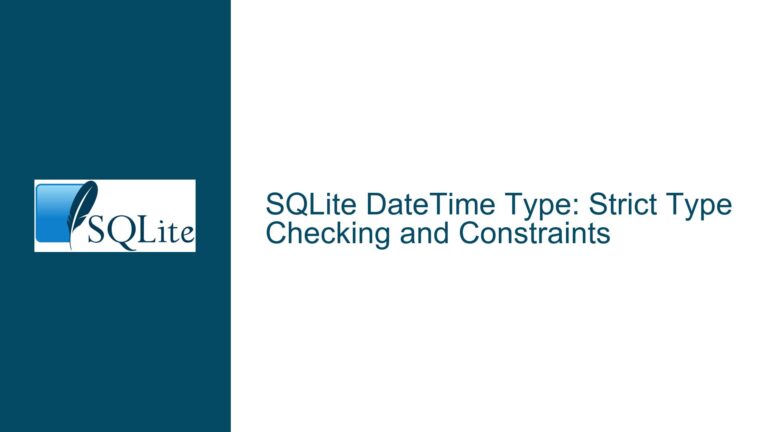SQLite Page Defragmentation and Cell Pointer Array Management
SQLite Page Structure and Fragmentation Dynamics
A SQLite database is organized into fixed-size pages, typically 4 KB in size. Each page is a self-contained unit that stores either table data (as B-tree pages) or index data (as B+-tree pages). The structure of a B-tree page is critical to understanding how SQLite manages storage efficiency and performance. A B-tree page comprises three primary regions: the page header, the cell pointer array, and the cell content area.
The page header contains metadata such as the page type, the number of cells on the page, and offsets to the start of free space. The cell pointer array is a contiguous block of 2-byte integers that serve as offsets pointing to the actual cell data stored in the cell content area. The cell content area grows backward from the end of the page, while the cell pointer array grows forward from the end of the page header. The space between the last cell pointer and the first cell is termed the unallocated region, which SQLite dynamically manages to accommodate future cell insertions or expansions.
Fragmentation occurs when cells are deleted or updated, leaving behind gaps in the cell content area. These gaps are classified into freeblocks (contiguous unused regions of 4 bytes or more) and fragmented bytes (smaller unused regions of 1–3 bytes). SQLite tracks these fragments in a linked list of freeblocks, with each freeblock header specifying its size and the location of the next freeblock. Fragmented bytes are not tracked individually but contribute to the total free space calculation. The cumulative size of all fragments (freeblocks and fragmented bytes) determines whether SQLite will trigger a defragmentation process. Specifically, defragmentation occurs when the total fragmented space reaches or exceeds 255 bytes. This threshold ensures that defragmentation costs (CPU and I/O) are justified by the space savings.
Mechanisms of Page Defragmentation in SQLite
Defragmentation is the process of consolidating fragmented free space into a single contiguous unallocated region. SQLite employs two primary strategies for defragmentation: full-page reconstruction and in-place cell shifting. The choice between these methods depends on the number of freeblocks present on the page.
Full-Page Reconstruction
When a page contains three or more freeblocks, SQLite opts for full-page reconstruction. This method involves creating a temporary copy of the original page in memory. The defragmentation algorithm then iterates over the cell pointer array, reading each cell from the copied page and writing it contiguously into a new buffer. This new buffer is built from the end of the page backward, ensuring that all cells are tightly packed without gaps. The unallocated region is maximized, and all freeblocks and fragmented bytes are eliminated. Finally, the original page is overwritten with the defragmented buffer. This approach guarantees optimal space consolidation but incurs higher CPU and memory overhead due to the copy operation.In-Place Cell Shifting
For pages with two or fewer freeblocks, SQLite attempts to defragment the page in place to reduce overhead. This method involves shifting cells within the existing page buffer to fill gaps left by freeblocks. For example, if a freeblock exists between two cells, SQLite may move the subsequent cells forward to occupy the freeblock’s space, thereby merging it into the unallocated region. This process is repeated for all freeblocks until no gaps remain. In-place shifting avoids the cost of copying the entire page but requires careful manipulation of cell offsets in the pointer array to maintain data integrity.
The defragmentation logic is implemented in the defragmentPage() function of SQLite’s source code. Key steps include:
- Iterating through the cell pointer array to collect all valid cell offsets.
- Sorting cells by their current positions to determine safe shifting order.
- Relocating cells to eliminate gaps, updating their offsets in the pointer array.
- Rebuilding the freeblock list if any residual free space remains (though this is rare after defragmentation).
Defragmentation not only improves space utilization but also enhances future insert/update performance by reducing the likelihood of fragmentation-related overhead.
Cell Deletion Dynamics and Cell Pointer Array Management
When a cell is deleted from a SQLite page, the database engine must update both the cell pointer array and the cell content area to reflect the change. The deletion process involves three key actions: removing the cell pointer, updating the free space tracking structures, and adjusting the cell pointer array.
Cell Pointer Array Adjustment
The cell pointer array is a dense array, meaning that all valid cell pointers are contiguous and ordered. When a cell is deleted, its corresponding pointer is removed from the array, and all subsequent pointers are shifted left by one position. For example, if a page contains five cells with pointers at offsets 0, 2, 4, 6, and 8, deleting the third cell (offset 4) would result in the fourth and fifth pointers (offsets 6 and 8) moving to positions 4 and 6, respectively. This ensures that the cell pointer array remains a gapless sequence of valid offsets, which simplifies cell lookup and iteration. Thesqlite3PagerTruncateArray()function in SQLite’s source code handles this pointer adjustment.Free Space Management
After deleting a cell, the space it occupied in the cell content area is converted into a freeblock. SQLite inserts this freeblock into the freeblock linked list, which is managed in order of increasing memory addresses. Each freeblock header contains:- A 4-byte size field (including the header itself).
- A 2-byte offset to the next freeblock in the list.
When a new cell is inserted, SQLite scans the freeblock list for a block large enough to accommodate the cell. If found, the freeblock is split into two parts: one for the new cell and a smaller residual freeblock (if sufficient space remains). If no suitable freeblock exists, the cell is placed in the unallocated region at the end of the cell content area.
Impact on Fragmentation and Performance
Frequent deletions can lead to freeblock proliferation, increasing the complexity of the freeblock list and raising the likelihood of fragmentation. Over time, this may degrade insertion performance as SQLite spends more time searching for suitable freeblocks. However, the defragmentation process mitigates this by periodically consolidating free space. Developers can influence defragmentation frequency indirectly by optimizing write patterns (e.g., batching deletions, avoiding small random updates) or using theVACUUMcommand to rebuild the entire database.
In summary, SQLite’s cell deletion and pointer array management mechanisms prioritize efficient space reuse while maintaining fast cell access. The interplay between freeblock tracking, defragmentation triggers, and pointer array adjustments ensures that the database remains performant even under moderate write-heavy workloads.






